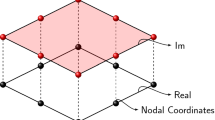Abstract
The finite element method is studied for its use in cracked and uncracked plates made of functionally graded materials. The material property variation is discretized by assigning different homogeneous elastic properties to each element. Finite Element results are compared to existing analytical results and the effect of mesh size is discussed. Stress intensity factors are calculated for an edge-cracked plate using both the strain energy release rate and the J-contour integral. The contour dependence of J in an inhomogeneous material is discussed. An alternative, contour independent integral \(\tilde J\) is calculated and it is shown numerically that \(\tilde J\), the strain energy release rate G, and the limit of J as Γ approaches the crack tip (where Γ is the contour of integration) are all approximately equal. A simple method, using a relatively coarse mesh, is introduced to calculate the stress intensity factors directly from classical J-integrals by obtaining lim#x0393;→ 0 J.
Similar content being viewed by others
References
ABAQUS, Theory Manual, Hibbitt Karlsson and Sorensen, Version 5.7, 1997.
Butcher, R.J., Rousseau, C.E. and Tippur, H.V. (1999). A functionally graded particulate composite: preparation, measurements and failure analysis.Acta Materialia 47(1), 259–268.
Delale, F. and Erdogan, F. (1983). The crack problem for a nonhomogeneous plane. Journal of Applied Mechanics 50, 609–614.
Eischen, J.W. (1987). Fracture of nonhomogeneous materials. International Journal of Fracture 34, 3–22.
Erdogan, F. (1995). Fracturemechanics of functionally gradient materials. Composites Engineering 5(7), 753–770.
Erdogan, F. and Wu, B.H. (1997). The surface crack problem for a plate with functionally graded properties. Journal of Applied Mechanics 64, 449–456.
Gibson, R.E. (1967). Some results concerning displacements and stresses in a nonhomogeneous elastic half space. Geotechnique 17, 58–67.
Gu, P. and Asaro, R.J. (1997a). Cracks in functionally graded materials. International Journal of Solids and Structures 34(1), 1–7.
Gu, P. and Asaro, R.J. (1997b). Crack deflection in functionally graded materials. International Journal of Solids and Structures 34(24), 3085–3098.
Gu, P., Dao, M. and Asaro, R.J. (1999). A simplified method For calculating the crack tip field of functionally graded materials using the domain integral. Journal of Applied Mechanics 66, 101–108.
Honein, T. and Herrmann, G. (1997). Conservation laws in nonhomogeneous plane elastostatics. Journal of Mechanics Physics Solids 45(5), 789–805.
Jin, Z.H. and Batra, R.C. (1996). Some basic fracture mechanics concepts in functionally gradient materials. Journal of Mechanics Physics Solids 44(8), 1221–1235.
Jin, Z.H. and Noda, N. (1994). Crack tip singular fields in nonhomogeneous materials. Journal of Applied Mechanics 61, 738–740.
Konda, N. and Erdogan, F. (1994). The mixed mode crack problem in a nonhomogeneous elastic plane. Engineering Fracture Mechanics 47, 533–545.
Lambros, J., Narayanaswamy, A., Santare, M.H. and Anlas, G. (1999). Manufacture and testing of a model functionally graded material. Journal of Engineering Materials and Technology 121(4), 488–493.
Li, H., Lambros, J., Cheeseman, B.A., Santare, M.H. (2000). Experimental investigation of the quasi-static fracture of a functionally graded material. International Journal of Solids and Structures (to appear).
Li, F.Z., Shih, C.F. and Needleman, A. (1985). A comparison of methods for calculating energy release rates. Engineering Fracture Mechanics 21(2), 405–421.
Parameswaran, V. and Shukla, A. (1998). Dynamic fracture of a functionally gradient material having discrete property variation. Journal of Materials Science 33, 3303–3311.
Rice, J.R. (1968). A path independent integral and the approximate analysis of strain concentration by notches and cracks. Journal of Applied Mechanics 35, 379–386.
Tohgo, K., Sakaguchi, M. and Ishii, H. (1996). Applicability of fracture mechanics in strength evaluation of functionally graded materials.JSME International Journal Series A 39(4), 479–488.
Author information
Authors and Affiliations
Rights and permissions
About this article
Cite this article
Anlas, G., Santare, M. & Lambros, J. Numerical Calculation of Stress Intensity Factors in Functionally Graded Materials. International Journal of Fracture 104, 131–143 (2000). https://doi.org/10.1023/A:1007652711735
Issue Date:
DOI: https://doi.org/10.1023/A:1007652711735




